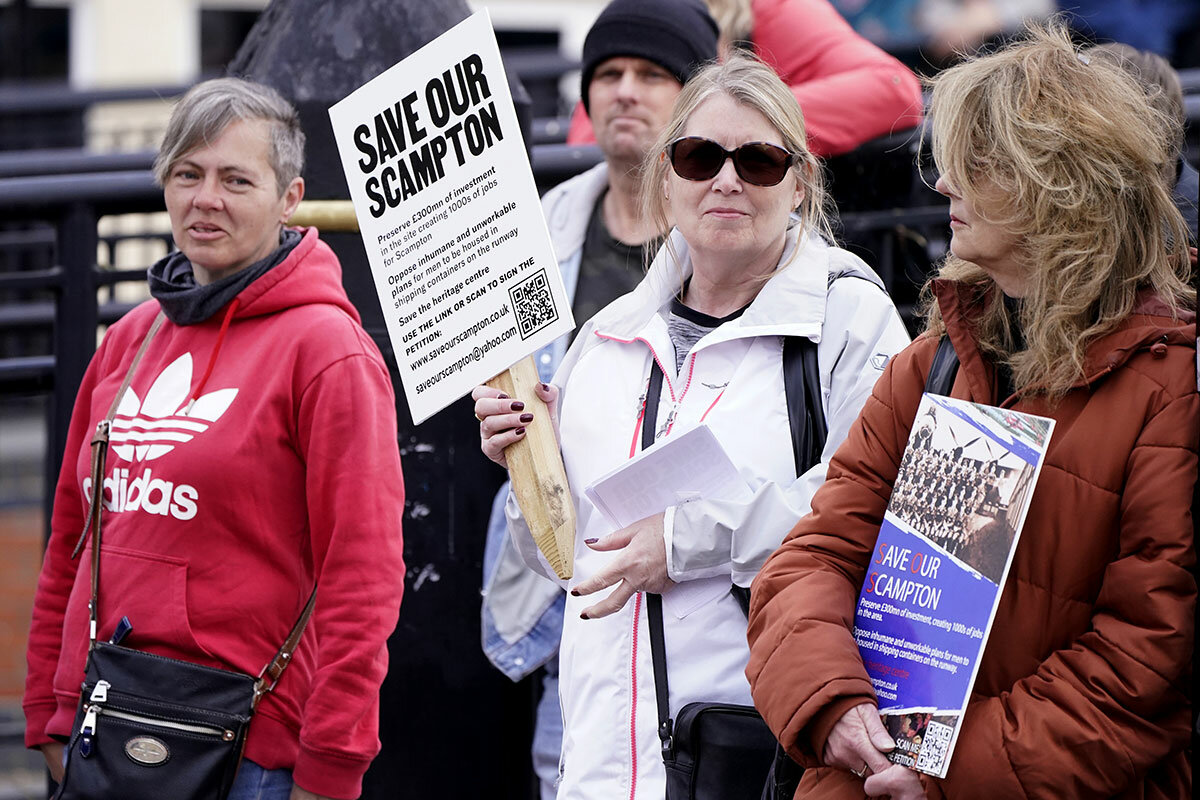What happens when you need immigrants, but don’t want them?
Loading...
| London
The United States and Britain are currently at the eye of similar political storms about how to establish control over a surge of migrants.
One thing is clear: Border control is only part of the answer.
Why We Wrote This
A story focused onIn the U.S., as in Britain, the economic imperative is for more immigration, but the political imperative is for less. Can governments reconcile this paradox?
The migrant issue is not a short-term problem. Twenty years ago, some 175 million people worldwide lived outside their native countries; that figure is now nearing 300 million. And America, like Europe, is aging. Their economies need workers in a range of services and industries.
These challenges could be met, on a policy level. But the problem isn’t policy. It is politics, where an increasingly partisan, populist, nationalist tone now colors the immigration debate in the U.S., Britain, and other Western democracies.
Real-life economic pressures are likely – eventually – to prod politicians on both sides of the Atlantic toward a policy mixing a better-funded, better-organized system to control migration, with an economically targeted welcome for immigrant workers.
The last time a bipartisan immigration policy emerged in America, Ronald Reagan was president. His legislative success provides a template, but he believed that immigration was “the great life force of each generation of new Americans.”
That is a reminder of how dramatically U.S. politics, and Mr. Reagan’s own Republican Party, have changed over the past 40 years.
The topography could hardly be more different: nearly 2,000 miles of cityscape and desert separate the United States from Mexico, while Britain’s southern coast, famed for its White Cliffs of Dover, is washed by the chilly, choppy waters of the English Channel.
Yet both the U.S. and Britain are at the eye of similar political storms: about how to establish control over a surge in migrants ready to risk imprisonment, deportation, violence, even their lives, to escape the lands of their birth.
That control could prove doable, if difficult. But the scramble for short-term policy fixes is masking a pair of deeper, long-term challenges facing the U.S., Britain, and other European nations.
Why We Wrote This
A story focused onIn the U.S., as in Britain, the economic imperative is for more immigration, but the political imperative is for less. Can governments reconcile this paradox?
Two challenges, with a clear policy message: Border control is only part of the answer.
Challenge number one is that the “migrant issue” is not a short-term problem. At the turn of the millennium, some 175 million people worldwide were living outside their native countries. That figure is now nearing 300 million. It is a tide swollen by wars, persecution, autocrats’ brutality, dysfunctional or collapsed states, the intensifying effects of climate change – and, quite simply, a lack of basic economic opportunities across much of the world.
Challenge number two is that the developed countries are aging. Their economies need workers in a range of services and industries – a need that is also feeding inflation and pushing up interest rates. And a 21st-century economy, in which innovation is critical, also benefits from immigrant researchers and entrepreneurs with a track record of contributing disproportionately to their new countries’ achievements.
Tackling those twin challenges, too, could prove doable, if difficult.
The problem isn’t policy. There is a broad center-ground consensus on what’s needed: immigration policies that welcome newcomers with the skills beneficial, and necessary, for their new host nations; a policy toward migrants that combines strong border security with an effective system for considering their cases; and initiatives to improve conditions in the countries they are fleeing.
What is holding back such an approach is politics: An increasingly partisan, populist, nationalist tone now colors the immigration debate in the U.S., Britain, and other Western democracies.
It is manifested in some politicians’ talk of a migrant “invasion,” a term British Home Secretary Suella Braverman used last year. And while many people are indeed worried by the changing ethnic mix of their communities, these concerns are sharpened by conspiracy theories such as the so-called Great Replacement, the notion of a shadowy international scheme to replace white, Christian natives with interlopers of different colors and faiths.
The result? A hardening of attitudes not just toward migrants arriving by rubber dinghy on the south coast of England, or crossing the Sonoran Desert on foot, but toward immigrants more generally.
In Britain last week, Ms. Braverman, who is Prime Minister Rishi Sunak’s chief law-and-order minister, pressed him not just to make good on his vow to “stop the boats” carrying desperate migrants to British shores, but to cut back sharply on all immigration.
Net migration into the U.K. reached a record high of around half a million last year, and it’s still rising. Ms. Braverman wants at least to bring it in line with her Conservative Party’s election pledge of four years ago, around 270,000 a year.
That presents a daunting problem for Mr. Sunak. A key selling point for Brexit, when Britons voted to leave the European Union, was that London would be able to keep out the East European plumbers, construction workers, and seasonal fruit and vegetable pickers who, as EU citizens, had enjoyed the right to work in Britain.
The new, non-EU influx – mostly from India, the Philippines, Nigeria, and Zimbabwe – has simply reflected market realities. These jobs still need doing, and Britons either can’t or won’t do them.
In America, too, the partisan debate over the southern border has undercut prospects for consensus on wider immigration issues.
Former President Donald Trump rode tough talk on border security to victory in 2016. His closest Republican Party challenger for the 2024 nomination, Florida Gov. Ron Desantis, is staking out an equally hard line. Speaking last weekend, Mr. DeSantis said he would “shut the border down immediately.”
Still, real-life pressures are likely – eventually – to prod politicians toward a policy mixing a better-funded, better-organized system to control migration, with an economically targeted welcome for immigrant workers.
In Britain, Chancellor of the Exchequer Jeremy Hunt has been pushing back against Ms. Braverman’s call for a wholesale reduction of immigration, arguing that this would damage economic growth. In fact, he said this week, he was open to expanding the list of “shortage occupations” – jobs where business is pressing for greater numbers of immigrant workers.
But in the U.S., the increasingly charged partisan divide seems likely to frustrate any bipartisan immigration breakthrough, at least for now. That last happened in 1986, under then-President Ronald Reagan: a crackdown on illegal immigration paired with an amnesty for tens of thousands of immigrants already in America.
In his final remarks as president, Mr. Reagan chose immigration as his theme. Calling it the “great life force of each generation of new Americans,” he said America’s strength rested on drawing in people “from every country and every corner of the world.”
“If we ever closed the door to new Americans,” he warned, “our leadership in the world would soon be lost.”
Mr. Reagan’s legislative success provides a possible template – but also a reminder of how dramatically U.S. politics, and his own Republican Party, have changed over the past 40 years.










